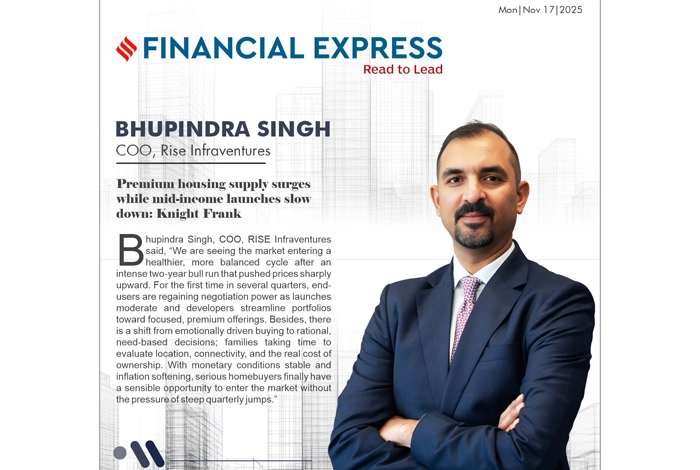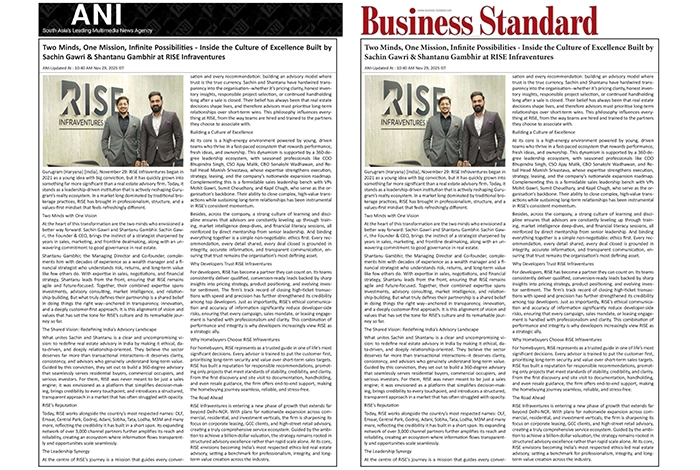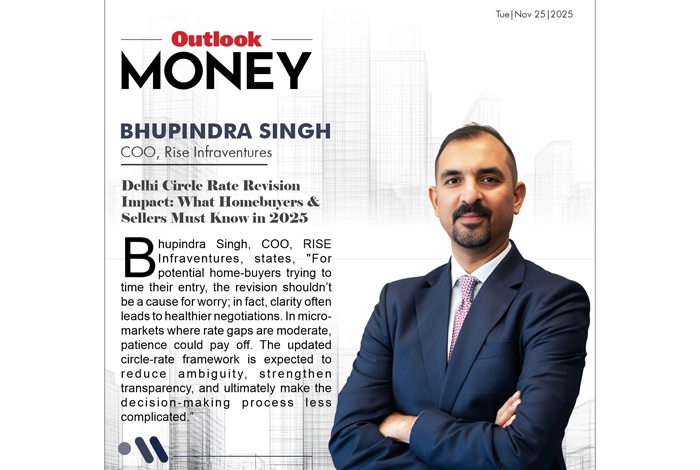Premium Housing Supply Surges While Mid-Income Launches Slow Down: Knight Frank

India's housing market is entering a calmer phase after two years of rapid growth. As mid-income project launches slow down and price momentum softens, homebuyers are gaining greater negotiating power, creating a more balanced, buyer-friendly environment.
Published By Financial Express
India's housing market is entering a new phase in 2025, and the latest Knight Frank NAREDCO Sentiment Index for Q3 2025 clearly captures this shift. After two years of strong growth, the sector is showing early signs of cooling, even as sentiment remains optimistic. The index reported that current sentiment improved to 59 from 56. In contrast, future sentiment remained stable at 61, indicating that the market has moved from a heated growth cycle into a more measured, balanced one.
One major change highlighted in the report is the sharp rise in premium housing launches. Developers are increasingly focusing on high-value projects, while supply in the mid-income category has slowed down noticeably. This shift confirms that the overall housing market has reached a steadier stage, creating an environment where end users can finally negotiate more freely after facing aggressive price hikes in 2023 and 2024.
Another key trend is the change in price expectations. According to the report, 92% of stakeholders expect prices to remain stable or rise, which is slightly lower than the 96% recorded last year. This decline, though marginal, signals that the steep price surge is easing. Buyers are showing resistance to inflated values, especially in non-premium categories, helping bring more balance to the market.
Office Market Stability Supports Homebuyer Confidence
Commercial real estate has played an essential role in supporting housing sentiment. The report notes that 95% of respondents expect office rents to stay stable or rise, while 78% expect new office supply to remain steady or grow slightly. Strong office leasing activity in Bengaluru, Hyderabad, and Pune has created a sense of security among urban homebuyers. Since many purchase decisions depend on job stability and future income visibility, the strength of the office market helps reinforce confidence in residential buying.
Regional performance also reflects this stability. The Southern region recorded a sentiment score of 62, continuing to lead the country, while the Northern region improved to 56. These areas are key drivers of the mid-income market, and stable job growth and construction progress in these zones help buyers make more rational, timely decisions.
Stable Funding Conditions Help Buyers Plan Better
The report highlighted that 86% of participants expected funding and liquidity conditions to remain steady or get better. With borrowing costs staying predictable, homebuyers could plan their mortgages more confidently, without worrying about sudden interest rate changes.
Developers, however, showed a more cautious outlook. Their future sentiment dropped from 63 to 59, while non-developer stakeholders held steady at 61. This indicates that developers will now prioritise projects with reliable presales and avoid taking risks on speculative launches.
According to Bhupindra Singh, COO of RISE Infraventures, the housing market is entering a more stable and balanced phase after two years of rapid price increases. He noted that end users are once again gaining negotiating power as the pace of new launches slows and developers refine their portfolios toward focused, premium offerings. He added that buyers are shifting from emotional decisions to practical, need-based choices, carefully assessing location, connectivity, and overall ownership cost. With inflation cooling and monetary conditions staying stable, genuine homebuyers finally have a comfortable window to purchase a home without facing the pressure of rapid, quarter-to-quarter price hikes.
Why This Period Is Favourable for Homebuyers
This is not a distressed or declining market. Instead, it is a controlled, rational phase in which buyers have time to explore options. Stable interest rates, easing inflation, slower mid-income launches, and softer price expectations all create a practical buying environment. Prices may not drop, but they will not rise at the earlier pace either.
Premium housing will continue to expand because demand from higher-income consumers and NRIs remains strong. However, this trend does not automatically translate into the mid-income segment, as both operate under very different demand drivers. As buyers become more selective, developers will need to work harder to justify costs in the mid-range.
Takeaway for End Users
For the first time in two years, end users hold real leverage. Developers will continue to prioritise premium housing, but mid-income launches will remain limited. This gives buyers the freedom to compare projects, negotiate better terms, and choose developers with strong delivery records. Q3 2025 marks a shift from urgency to balance, offering mid-income households a more stable and sensible path to homeownership.
Frequently Asked Questions
1. Why is the premium housing supply increasing in India?
Premium housing supply is increasing as developers focus on high-value projects with stronger presales and higher profit margins. Demand from high-income buyers and NRIs also remains strong, encouraging more premium launches.
2. Why are mid-income housing launches slowing down?
Mid-income launches are slowing as developers become cautious. They prefer projects with predictable demand, and the mid-income segment is showing resistance to higher prices, leading developers to limit new supply.
3. What does the Knight Frank Sentiment Index indicate for Q3 2025?
The index shows a balanced market. Current sentiment rose to 59, future sentiment remained at 61, and stakeholders expect stable pricing. This signals a shift from a fast-paced market to a steady, more controlled phase.
4. How does stable funding help homebuyers?
Stable funding and predictable borrowing costs allow buyers to plan mortgages with confidence. With no sudden rate shocks, homebuyers can evaluate long-term affordability more accurately.
5. Why is this period favourable for end users?
This phase is favourable because prices are moderating, launches are more balanced, inflation is easing, and interest rates are stable. Buyers now have greater negotiation power and more time to assess properties before making a decision.




